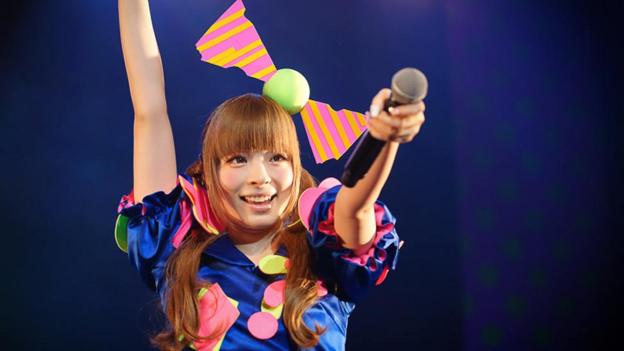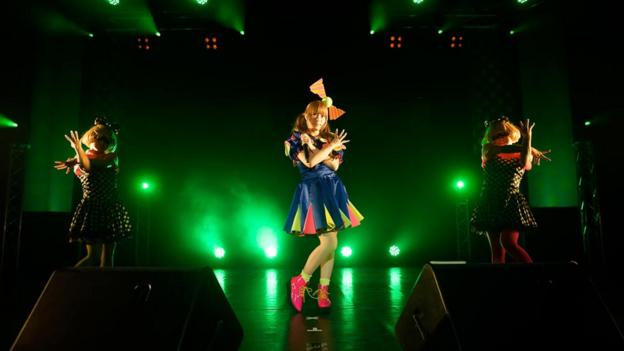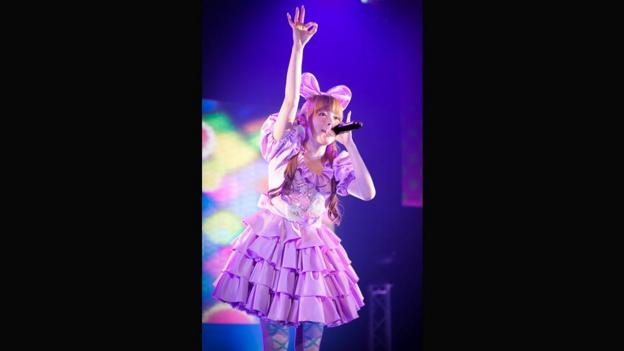







HIDE CAPTION
- Fan girls
- Kyary Pamyu Pamyu performs at Singapore's Scape Warehouse in Orchard. Many Singaporean fans attended the concert dressed like her. (Asobi System)
J-Pop has been popular in Asia for years. But a new star, Kyary Pamyu Pamyu has found global fame with her reinvention of ‘kawaii’ culture, Mariko Oi reports.
A room full of children's toys, a dancing brain, a psychedelic shark and, in the middle, a girl doing a quirky dance: this is how the world first discovered Japanese artist Kyary Pamyu Pamyu.
The music video of her debut song PonPonPon was uploaded to YouTube in July 2011 and soon attracted attention around the world, topping iTunes' electronic songs charts as far afield as Belgium and Finland. As of June 2013, the video – which sees skulls and dinosaurs spin around Kyary as bats and eyeballs fly out of her mouth – has been viewed nearly 50 million times.
"Only in Japan!" wrote commenters on YouTube.
Today, Kyary is the face and the voice of Japan’s ‘kawaii’ or ‘cute’ culture – but with a new twist. Kawaii used to be about Hello Kitty, or schoolgirls obsessed with making their eyes look bigger, like Barbie dolls.
But Kyary, whose real name is Kiriko Takemura, has been pushing the boundaries of kawaii by embracing the grotesque as part of her image – just think of the bats and skulls in the PonPonPon video. The 20-year-old artist is often compared with Lady Gaga for her unique sense of fashion. Her inspiration, Katy Perry, has praised her songs. But this new-found fame is not something she actively pursued.
Harajuku girl
"I was still at school when a fashion magazine took a photo of me on the street in Harajuku [a trendy youth district in Tokyo]. That's when I started modelling," she says, speaking backstage before a concert in Singapore as part of her global tour.
"About a year later, they asked me if I would be interested in being a DJ at an event called Takenoko, which was a clubbing event for teenagers."
"I thought it would be fun so I started DJing. That's where I met my producer and we released my debut song in 2011," she adds. And that song was PonPonPon.
Everywhere she goes – the US, Europe and Asia – she is greeted by fans dressed just like her. "It's still surreal but it makes me very happy to see my fans outside Japan," she says.
Kyary represents a new kind of J-Pop, or Japanese popular music. It has had a following in Asia for decades, but –until now had failed to capture the rest of the world’s attention.
"She is a combination of dance music and Harajuku fashion, which is what I always wanted to create," her producer Yasutaka Nakata explains.
The 33-year-old songwriter has some experience of shaking up the J-Pop industry. He made his debut as a performer with the band Capsule in 2001, before producing music for other popular groups.
"Since I was a child, I have always liked experimenting with sound, and that's what I continue to do,” he says from his office on the Harajuku street where Kyary's fashion was born. "I've always made music for my own pleasure and that hasn't changed."
Commercial success, let alone global appeal, may not be on his mind. But the combination of his music, catchy lyrics and Kyary's style has attracted worldwide attention and propelled them to fame .
An imperfect world
"What is different about Kyary is that she is not afraid to be uncool," Mr Nakata says. "She is confident about what she likes, so as long as it feels right to her, she'll sing any odd lyrics that I come up with."
The lyrics can be annoyingly catchy and often don't say much. A case in point: one of Kyary's songs is titled Tsukema Tsukeru, literally '"putting on fake eyelashes". The lyrics of many songs don’t make grammatical sense and the music too, Nakata says, is full of deviations from the norm.
But these imperfections, according to J-Pop's young mastermind, are what the kawaii culture is about. "I think it derives from our own inferiority complexes, so we try to treat our shortcomings as positive by making them cute," he said.
"For example, if a child is playing piano badly, that's cute. I am trying to create that imperfection with my music."
It is a stark contrast to the more common international perception of Japan – a conformist, rule-focused nation that strives for perfection.
Business manners are renowned for being very formal. There are unspoken rules on how much to bow depending on social status or age of the person you bow to. Giving or receiving business cards with one hand is considered rude. Traditional art forms such as tea ceremonies and classical kabuki theatre also have rigid etiquette rules and mastering them take many years to perfect.
Kyary’s fast rise to global fame, her quirkiness and imperfections fly in the face of the conventional view of Japanese culture. Whether Kyary Pamyu Pamyu is a passing trend or true phenomenon remains to be seen. But for the moment, it may be the clash of two such different images of Japan that continues to fascinate the world.
The music video of her debut song PonPonPon was uploaded to YouTube in July 2011 and soon attracted attention around the world, topping iTunes' electronic songs charts as far afield as Belgium and Finland. As of June 2013, the video – which sees skulls and dinosaurs spin around Kyary as bats and eyeballs fly out of her mouth – has been viewed nearly 50 million times.
"Only in Japan!" wrote commenters on YouTube.
Today, Kyary is the face and the voice of Japan’s ‘kawaii’ or ‘cute’ culture – but with a new twist. Kawaii used to be about Hello Kitty, or schoolgirls obsessed with making their eyes look bigger, like Barbie dolls.
But Kyary, whose real name is Kiriko Takemura, has been pushing the boundaries of kawaii by embracing the grotesque as part of her image – just think of the bats and skulls in the PonPonPon video. The 20-year-old artist is often compared with Lady Gaga for her unique sense of fashion. Her inspiration, Katy Perry, has praised her songs. But this new-found fame is not something she actively pursued.
Harajuku girl
"I was still at school when a fashion magazine took a photo of me on the street in Harajuku [a trendy youth district in Tokyo]. That's when I started modelling," she says, speaking backstage before a concert in Singapore as part of her global tour.
"About a year later, they asked me if I would be interested in being a DJ at an event called Takenoko, which was a clubbing event for teenagers."
"I thought it would be fun so I started DJing. That's where I met my producer and we released my debut song in 2011," she adds. And that song was PonPonPon.
Everywhere she goes – the US, Europe and Asia – she is greeted by fans dressed just like her. "It's still surreal but it makes me very happy to see my fans outside Japan," she says.
Kyary represents a new kind of J-Pop, or Japanese popular music. It has had a following in Asia for decades, but –until now had failed to capture the rest of the world’s attention.
"She is a combination of dance music and Harajuku fashion, which is what I always wanted to create," her producer Yasutaka Nakata explains.
The 33-year-old songwriter has some experience of shaking up the J-Pop industry. He made his debut as a performer with the band Capsule in 2001, before producing music for other popular groups.
"Since I was a child, I have always liked experimenting with sound, and that's what I continue to do,” he says from his office on the Harajuku street where Kyary's fashion was born. "I've always made music for my own pleasure and that hasn't changed."
Commercial success, let alone global appeal, may not be on his mind. But the combination of his music, catchy lyrics and Kyary's style has attracted worldwide attention and propelled them to fame .
An imperfect world
"What is different about Kyary is that she is not afraid to be uncool," Mr Nakata says. "She is confident about what she likes, so as long as it feels right to her, she'll sing any odd lyrics that I come up with."
The lyrics can be annoyingly catchy and often don't say much. A case in point: one of Kyary's songs is titled Tsukema Tsukeru, literally '"putting on fake eyelashes". The lyrics of many songs don’t make grammatical sense and the music too, Nakata says, is full of deviations from the norm.
But these imperfections, according to J-Pop's young mastermind, are what the kawaii culture is about. "I think it derives from our own inferiority complexes, so we try to treat our shortcomings as positive by making them cute," he said.
"For example, if a child is playing piano badly, that's cute. I am trying to create that imperfection with my music."
It is a stark contrast to the more common international perception of Japan – a conformist, rule-focused nation that strives for perfection.
Business manners are renowned for being very formal. There are unspoken rules on how much to bow depending on social status or age of the person you bow to. Giving or receiving business cards with one hand is considered rude. Traditional art forms such as tea ceremonies and classical kabuki theatre also have rigid etiquette rules and mastering them take many years to perfect.
Kyary’s fast rise to global fame, her quirkiness and imperfections fly in the face of the conventional view of Japanese culture. Whether Kyary Pamyu Pamyu is a passing trend or true phenomenon remains to be seen. But for the moment, it may be the clash of two such different images of Japan that continues to fascinate the world.








No comments:
Post a Comment